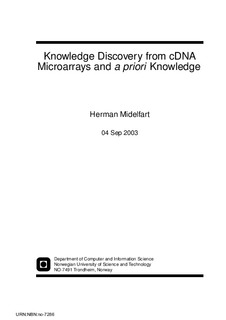| dc.contributor.author | Midelfart, Herman | nb_NO |
| dc.date.accessioned | 2014-12-19T13:30:28Z | |
| dc.date.available | 2014-12-19T13:30:28Z | |
| dc.date.created | 2003-09-04 | nb_NO |
| dc.date.issued | 2003 | nb_NO |
| dc.identifier | 126222 | nb_NO |
| dc.identifier.uri | http://hdl.handle.net/11250/249990 | |
| dc.description.abstract | Microarray technology has recently attracted a lot of attention. This technology can measure the behavior (i.e., RNA abundance) of thousands of genes simultaneously, while previous methods have only allowed measurements of single genes. By enabling studies on a genome-wide scale, microarray technology is currently revolutionizing biological research and creating a wide range of research opportunities. However, the technology generates a vast amount of data that cannot be handled manually. Computational analysis is thus a prerequisite for the success of this technology, and research and development of computational tools for microarray analysis are of great importance.
This thesis develops supervised learning methods based on Rough Set Theory (RST) for analyzing microarray data together with prior knowledge. Two kinds of microarray studies are considered.
The first is cancer studies where supervised learning may be used for predicting tumor subtypes and clinical parameters. We introduce a general RST approach for classification of tumor samples analyzed by microarrays. This includes a feature selection method for selecting genes that discriminate significantly between a set of classes. RST classifiers are then learned from the selected genes.
The approach is applied to a data set of gastric tumors. Classifiers for six clinical parameters are developed and demonstrate that these parameters can be predicted from the expression profile of gastric tumors. Moreover, the performance of the feature selection method as well as several learning and discretization methods implemented in ROSETTA are examined and compared to the performance of linear and quadratic discrimination analysis. The classifiers are also biologically validated. One of the best classifiers is selected for each clinical parameter, and the connection between the genes used in these classifiers and the parameters are compared to the established knowledge in the biomedical literature. Many of these genes have no previously known connection to gastric cancer and provide interesting targets for further biological research.
The second kind of study is prediction of gene function from expression profiles measured with microarrays. A serious problem in this case is that functional classes, which are assigned to genes, are typically organized in an ontology where the classes may be related to each other. One example is the Gene Ontology where the classes form a Directed Acyclic Graph (DAG). Standard learning methods such as RST assume, however, that the classes are unrelated, and cannot deal with this problem directly. This thesis gives a solution by introducing an extended RST framework and two novel algorithms for learning in a DAG.
The DAG also constitutes a problem when a classifier is to be evaluated since standard performance measures such as accuracy or AUC do not recognize the structure of the DAG. Therefore, several new performance measures are introduced.
The algorithms are first tested on a data set that was created from human fibroblast cells by the means of microarrays. They are then applied on artificial data in order to obtain a better understanding of their behavior, and their weaknesses and strengths are identified. | nb_NO |
| dc.language | eng | nb_NO |
| dc.publisher | Institutt for datateknikk og informasjonsvitenskap | nb_NO |
| dc.relation.ispartofseries | Doktoravhandlinger ved NTNU, 1503-8181; 2003:65 | nb_NO |
| dc.subject | bioinformatikk | no_NO |
| dc.subject | mikroarrayer | no_NO |
| dc.subject | genetikk | no_NO |
| dc.subject | Genetikk | no_NO |
| dc.subject | Dataanalyse | no_NO |
| dc.title | Knowledge discovery from cDNA microarrays and a priori knowledge | nb_NO |
| dc.type | Doctoral thesis | nb_NO |
| dc.source.pagenumber | XII, 234 s. ill. | nb_NO |
| dc.contributor.department | Norges teknisk-naturvitenskapelige universitet, Fakultet for informasjonsteknologi, matematikk og elektroteknikk, Institutt for datateknikk og informasjonsvitenskap | nb_NO |
| dc.description.degree | dr.ing. | nb_NO |
| dc.description.degree | dr.ing. | en_GB |
